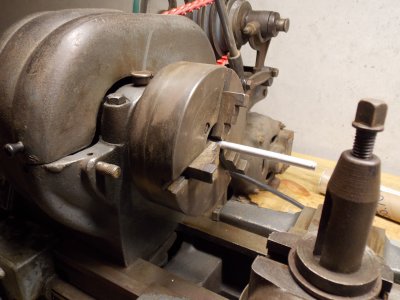Stand the jaws on the bench or table in front of you with the interrupted threads up and the short Vee gripping surfaces nearest to you. The thread nearest to you will also be nearest to the bench surface. The "first" thread is defined as the first one to engage the scroll when installing the jaws. The jaw with the first interrupted thread nearest to the short Vee gripping surface and nearest to you is #1. The one with the first thread farthest from you and farthest from the Vee is #3. And the other one is #2.
Good advice,
but. . . There is an "old school" designation for chuck jaws being that what you have was called "lathe" jaws and the reverse was called a "drill" chuck. That's a very old designation from old books and I'm sure has been replaced by "inside" and "outside" gripping. Now that I've confused you a little, let's get even more so.
There are chucks,
rare but. . . , that are both inside and outside gripping. Take the jaws out and look at the back side where they connect with the "scroll". They will be slightly curved to mate with the scroll. If they are curved on both sides,
no that's not a good description. . . If the jaw teeth form an oval on the back, a "truncated" oval, they
may be inserted in either direction. Number 1 and 3 are swapped, based on the position of the teeth. Since the chuck body is numbered and the jaws are not,
and it is obviously a very old chuck, it is
possible that you have lucked into this type of chuck. The style was rare for even on old machines, but did exist. Sold for "hobby" level machines. . . The largest I have ever seen is a 5 inch chuck. I have a 3 inch that has the reversible jaws, so I know they did exist.
You might get lucky. . . If you have managed to acquire a reversible jaw chuck, up front I will offer to buy you a new chuck, with both sets of jaws, in exchange for your old one. Not a fancy one mind you, just something usable to a beginner.
A quick way to check for this style of chuck is to try to insert a jaw "backwards". Any one, if it won't get far enough for the second it isn't a reversable jaw. Just turning the key by hand lightly, do not use any force. If you do have a reversible jaw chuck, the jaws can be determined by setting them on a bench with the long jaw away from you so that they are tilted toward you. There will be a slight offset in the teeth. Set them in order so that there is a slight progression from one to the next. The one closest to you is number 1 for "lathe" usage. For "drill" usage, swap number 1 and 3. The slight progression is still there, just in the opposite direction.
One other point, not just for reversible chucks but for any. The teeth closest to the end of insertion will be number one. Try the set in each slot, one at a time of course. Chuck up a fairly smooth rod. I have a bar from an old printer, a piece of drill rod would do better. Run it around by hand to measure runout. When you have determined the best (lowest) runout, mark the jaws to match the chuck. Slow and methodical will pay off in the long run.
This chuck has had some pretty hard use and I think even the wear showing up on the jaws may be a factor also, the jaws do appear to come together correctly.
Checking by eye is not sufficient. The ideal target is less than a thou. Realisticly, with an older chuck, a few thou is good. Try all three positions and ID the jaws to the best (lowest) runout, matching the numbers on the chuck body. Lining up visually means you have the jaws in proper sequence. The runout should be measured with some type of indicator. The difference cannot be seen by eye, unless you have
very sharp vision. There are times when the human eye can resolve a half thou, this is not one of those times.
The nature of the closing mechanism, the scroll and teeth, will vary based on the diameter of the work. The optimum closure to measure is near the normal working area that fits what you normally do. If you use a 1/2 inch drill as a test bar, your measurement would be most accurate at that 1/2 inch. Smaller or greater diameters will tend to drift away from optimal from there. But as noted, if the OD of the work has to be sized, the whole issue is moot.
.

